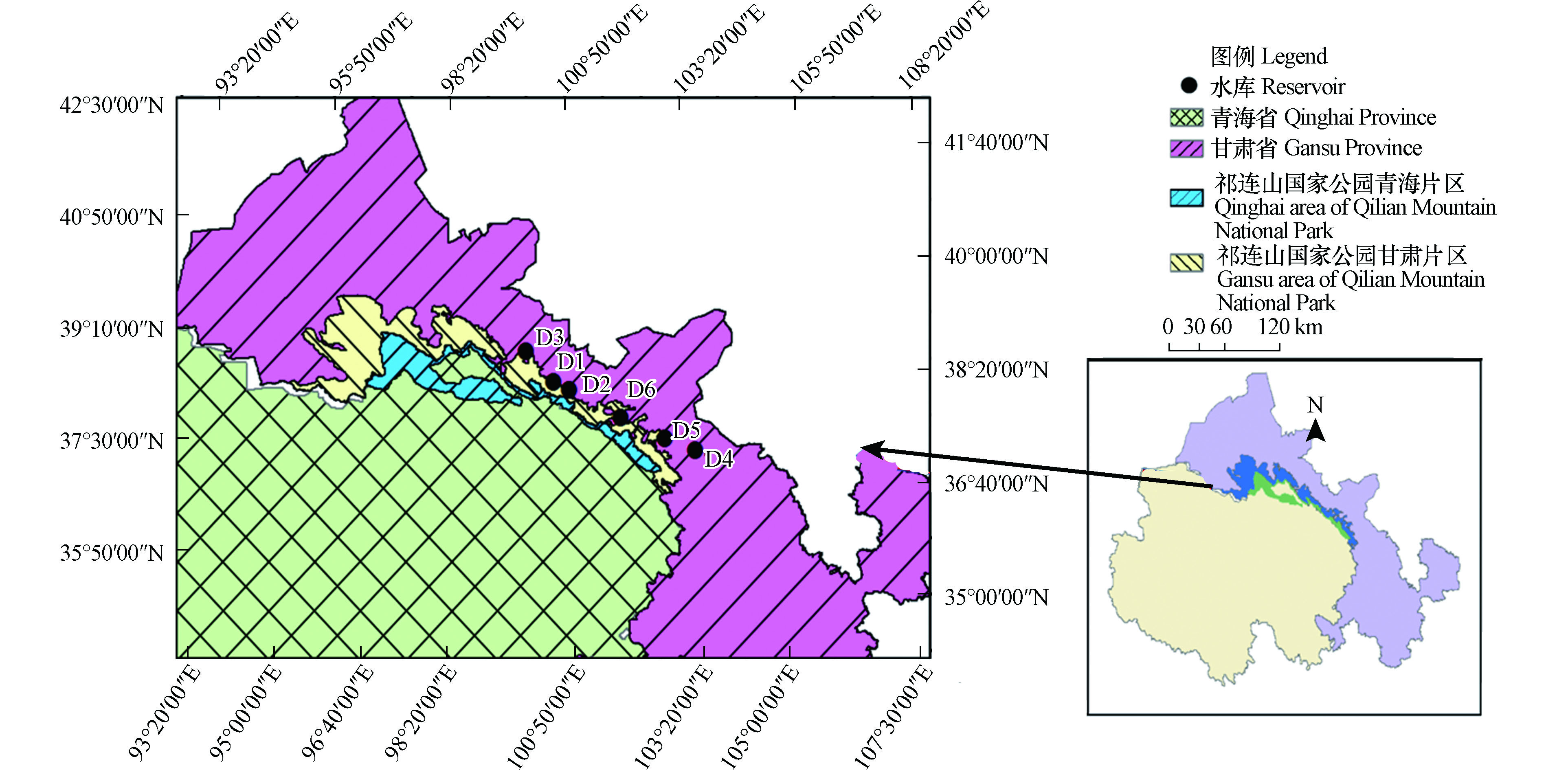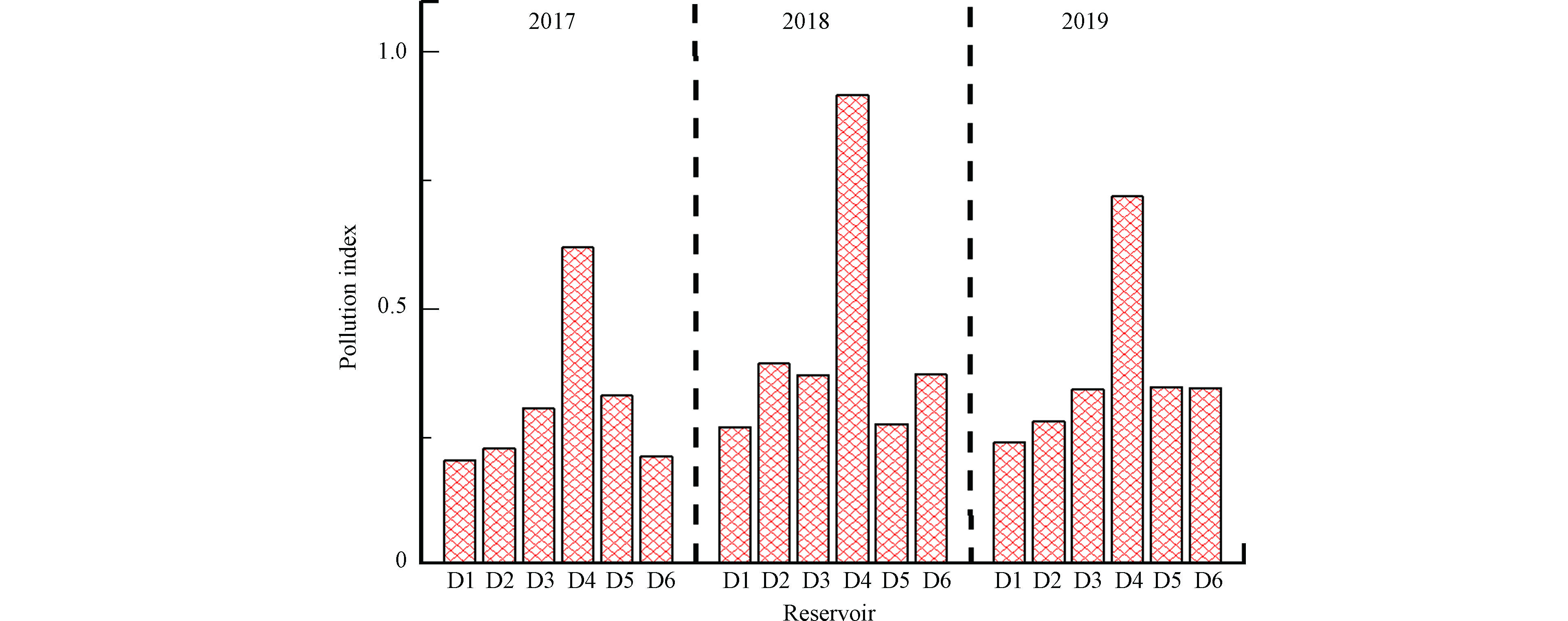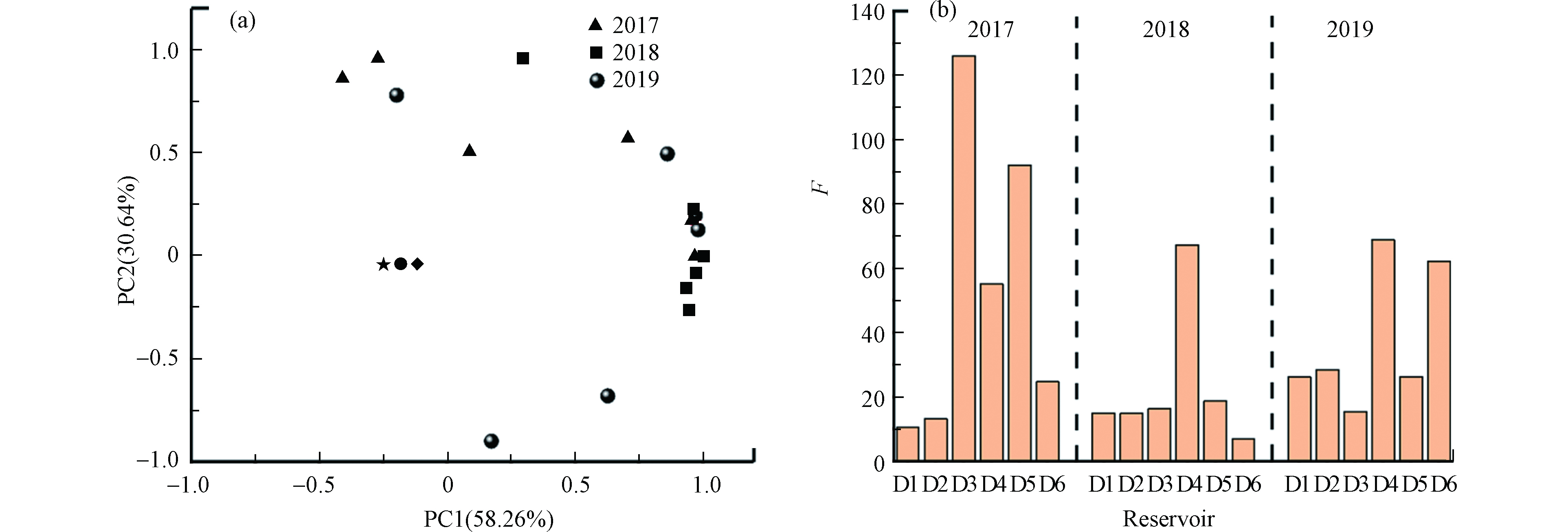-
水环境评价是针对某流域、水库开展系列监测,根据各类评价模型以及水环境质量标准对各项指标开展定量评价,全球每年因水环境污染引发健康问题的人超过80万人[1],因此,确定水环境质量及水质受污染状况,是保障水环境安全、保障居民健康及合理开发水资源的重要举措[2]。常见的水质评价方法主要有单因子评价法,综合污染指数法,主成分分析法,模糊综合评价法,神经网络法和支持向量法等[3-7]。以上各类方法在实际应用中各有优缺,往往单一的一种评价方法并不能准确全面体现水质情况,通常需要多种评价方法的结合,丛铭等[8]采用了单因子评价与模糊综合评价法针对辽河口水质进行评价分析,两种评价方法的结合,使得评价结果更科学合理。朱长军等[9] 采用主成分分析法及WQI污染指数法对大黑汀水库水质进行综合评价,在充分考虑指标权重,得出水库以有机污染为主。董颖等[10]采用主成分分析法及熵值法结合,得出了较为科学的水源地水质,分析得出冬季水质明显优于夏季,锰是尤家峁水库水质恶化的主导因素。Giao 等[11]针对越南湄公河三角洲地区饮用水采用了集对分析法以及水质指数法进行分析评价,结果表明影响该地区水质的主要特征污染物为有机物、NH3-N以及大肠菌群。
祁连山地处青藏高原东北部,分布于甘肃、青海两省,是我国西部地区重要的生态安全屏障与重要的水源产流地,也是我国重点生态功能区和生物多样性保护优先区域[12-14]。区域内分布着大大小小的水库、水电站数十座,不少水库是作为饮用水水源。针对祁连山地区,张玉凤等[15]采用单因子评价法对祁连山区域内双树寺水库进行水质评价,得出当TN不参评时,水库水质可达《地表水环境质量标准》(GB3838—2002)中Ⅰ类水体。蒋丽君等[16]采用单因子评价法对祁连山自然保护区内主要河流进行水质评价,结果显示在TN不参评时,2012至2016年Ⅰ—Ⅲ类水体占比达80%以上,按地表水功能区水质管理目标评价全部达标。
祁连山国家公园水库水质评价的相关研究较少,已有研究也仅仅只是针对某一水库采用单一的方法进行了水质评价,缺乏对祁连山饮用水源水库系统,综合全面的评价研究。为明确祁连山国家公园内饮用水源水质特征及水环境状况,本文选择了国家公园内6座主要流域上,作为饮用水水源的水库,采用了单因子评价法、综合污染指数法、主成分分析法分别对水库2017—2019年水环境质量进行评价,旨在明确祁连山饮用水源水环境质量状况,为祁连山国家公园内饮用水源地保护及水环境治理提供支撑,为祁连山国家公园管理提供帮助。
-
祁连山地处甘肃和青海两省,属于大陆性高寒半湿润山地气候,研究区选取祁连山区域99°26′27″E—103°40′45″E,37°20′47″N—39°0′0″N。该区域位于甘肃省张掖市,武威市境内,生活人口较多,年平均降雨量在300—400 mm间,海拔位于1640—2470 m。选取的典型水库包括D1(瓦房城水库,100°30′13″E,38°28′02″N),D2(双树寺水库,100°49′30″E,38°20′51″N),D3(鹦鸽嘴水库,99°56′54″E,38°55′59″N),D4(大靖峡水库,103°20′45″E,37°22′47″N),D5(黄羊河水库,102°43′36″E,37°34′46″N),D6(皇城水库,101°51′13″E,37°55′02″N)。以国家公园内张掖市为核心,武威市、金昌市各选择几座库容大,具有饮用水源、发电、养殖等功能的典型水库作为研究对象。具体分布见图1。
-
对大野口水库在内的6个水库2017—2019年的3年水质进行了取样检测,每月取样检测1次,取样参照相关方法,选择水库不同深度(水面下0.5 m,水深1/2处及水底上0.5 m处)的水样取样后混合检测。选取pH、DO、CODMn、BOD5、NH3-N、TN、TP、氟化物、石油类、粪大肠菌群数11项污染物指标为基础项进行分析。对监测指标年平均值进行分析评价,按照GB3838—2002《地表水环境质量标准》和《水和废水监测分析方法》(第4版)[17]中规定的方法进行水质检测分析。
-
将所得实验数据利用EXCEL2016进行处理,利用Origin2017软件进行图形的绘制与分析,采用Matlab2016a进行主成分分析。
本文选用了单因子评价法、综合污染指数法、主成分分析法进行水质评价。单因子评价是水质评价中最基本的方法,通过对各个指标与水质标准中规定的指标逐一对照,完成水质评价;综合污染指数法(K)是通过简单的数值计算与分析,完成水质污染程度的评价;主成分分析法较为复杂,但是可以对6座水库的整体水质情况进行定性分析,这3种水质评价方法结合可以客观准确的对祁连山国家公园水质情况进行评价分析。
-
单因子评价法采取一票否决的原则,将各项参评指标与评价标准值一一对比,将最差水质指标作为该水体的水质评价结果,如有一项指标超出评价标准,则视为该水体未达到标准[18]。
-
综合污染指数法作为我国第一个综合评价水环境质量状况的指标,方法简单,目前也广泛应用于水质评价。其表达式为[19,20]:
式中,
$ {p}_{i} $ 是污染物检测浓度(mg·L−1);$ {p}_{{o}_{i}} $ 为污染物评价指标值;$ {p}_{k} $ 是指污染物评价标准值,此值为0.1。综合污染指数法分级标准为6类:K≤0.1一般指水体未受到污染、0.1≤K≤0.2一般指水体受到轻微污染、0.2≤K≤0.5一般指水体受到轻度污染、0.5≤K≤1.0一般指水体受到中度污染、1.0≤K≤5.0一般指水体受到重度污染,K≥5.0一般指水体受到严重污染。 -
主成分分析法也叫主量分析,是利用降低维度的理念在很少损失信息的前提下将多个因素转化为几个综合因素的统计学分析方法[21-23],筛选出能解释大部分资料的综合指标,从而进行综合分析评价。具体计算如下:
(1)数据标准化。为了消除因为单位不同而带来的影响,通常使用数据标准化公式来对数据进行统一处理。
(2)计算相关系数矩阵。原始数据经标准化处理得到标准化矩阵
$ {\left({x}_{ij}\right)}_{p\times n} $ ,然后计算相关系数矩阵$ {R=\left({r}_{ij}\right)}_{n\times n} $ ,R为n阶对称矩阵式中,
$ {r}_{ij} $ ($ i,j=\mathrm{1,2},\cdots n $ )是$ {x}_{i} $ ,$ {x}_{j} $ 的相关系数,(3)计算相关系数矩阵R的特征值,特征向量。求R的特征值向值
$ {\lambda }_{i}(i=\mathrm{1,2},\cdots n) $ 及其对应的特征向量$ {\alpha }_{i}(i=\mathrm{1,2},\cdots n) $ ,$ {\lambda }_{1}\ge {\lambda }_{2}\dots \ge {\lambda }_{n} $ 。(4)计算贡献率,确定主成分。贡献率
$ {\eta }_{i}=\dfrac{{\lambda }_{i}}{ \displaystyle \sum _{i=1}^{n}{\lambda }_{i}}\times 100\text{%} $ 为主成分$ {F}_{i} $ 的贡献率;(5)计算累计方差贡献率
$\displaystyle \sum _{i=1}^{n}{\eta }_{i}$ 。(6)计算各主成分表达式 Fi。即主成分荷载值 lij与对应的标准化后的指标值 xij 相乘。
(7)计算主成分综合得分值 F。即各主成分得分值 Fi 与相应权重的乘积之和。
-
由图2a可得水库水体pH值在8.14—8.35间,各水库水体间pH波动较小,水库年均值波动也较小,整体呈中性偏弱碱性。2017年D1—D6水库氨氮的年均浓度为0.19、0.23、0.33、0.13、0.06、0.06 mg·L−1,2018年为0.26、0.30、0.32、0.92、0.20、0.16 mg·L−1,2019年分别为0.25、0.28、0.23、0.46、0.17、0.09 mg·L−1,2018年各水库氨氮平均浓度最高,而且2017—2018年氨氮有升高趋势,但均低于《地表水环境质量标准》(GB3838—2002)Ⅲ类水体氨氮的限值。图2c中D4水库氨氮浓度最高,王菊琴等[24]通过对大靖峡水库周边环境,点源污染及面源污染分析得出大靖峡水库污染源主要来自水库淤积物、生活垃圾等外源污染物在水库中缓慢扩散,释放产生;其次由于地处干旱半干旱地区,水土流失导致地表植被进入水体中腐败后产生大量内源污染物。图2d为各水库TN变化情况,2017年D1—D6水库TN的年均浓度为1.33、1.42、1.92、3.05、2.13、1.38 mg·L−1,2018年为1.88、2.30、2.65、4.50、1.61、2.53 mg·L−1,2019年分别1.69、1.88、2.05、5.01、2.29、1.38 mg·L−1,2017—2019年间TN浓度先升后降,2018年各水库TN平均浓度最高,结合王昱等[25]对祁连山黑河流域研究发现,枯水期污染物浓度普遍高于平水期与丰水期,资料显示[26]2018年祁连山地区金昌、武威等市年降雨量相较2017年与2019年有所减少,可能是2018年TN含量偏高的主要原因。2017—2019年年所有水库TN均超出《地表水环境质量标准》(GB3838—2002)中Ⅴ类水体规定的TN标准限值,D1、D2与D6水库周围分布居民较少,距离城镇较远,排入水体中的外源污染物较少,这可能是TN含量低于其他水库的主要原因。
图2e为各水库TP浓度变化情况,D1—D6水库2017年TP的年均浓度为0.014、0.012、0.021、0.126、0.039、0.023 mg·L−1,2018年为0.016、0.046、0.020、0.156、0.034、0.040 mg·L−1,2019年分别0.011、0.020、0.041、0.050、0.040、0.091 mg·L−1,2017—2019年6座水库中83.33%的水库TP浓度低于地表水低于《地表水环境质量标准》(GB3838-2002)Ⅲ类水体的限值,且大多数低于地表水Ⅱ类水体规定的标准限值,其中D4水库D6水库TP含量波动较大,结合杨冰等[27]分析国家级自然保护区黑河湿地水质TP含量的变化主要受人类活动的影响,D4、D6水库周边及上游区域居民较多[28],水体受污染较为严重。
-
图2b为各水库高锰酸盐含量变化,D1—D6水库2017年高锰酸盐的年均浓度分别为1.22、2.11、1.93、2.70、1.55、1.11 mg·L−1,2018年为1.22、2.34、1.91、3.55、1.36、1.21 mg·L−1,2019年分别0.98、1.54、1.67、3.15、1.69、1.16 mg·L−1,2017—2019年各水库高锰酸盐含量呈降低趋势,均低于地表水低于《地表水环境质量标准》(GB3838—2002)Ⅲ类水体的限值,且到2019年除D4水库外,其余各水库高锰酸盐含量均低于Ⅰ类水体的限值。这与近两年政府在祁连山国家公园内开展的集中严格的水环境治理有密切关系。2018年高锰酸盐浓度最高,这与图2中TN、氨氮及TP的规律类似。
-
图2f为各水库粪大肠菌群数变化,D1—D6水库2017年粪大肠菌群的年均值分别为45、57、668、280、485、123 个·L−1,2018年为50、47、55、305、69、10 个·L−1,2019年分别55、60、28、156、55、145 个·L−1,2017—2019年水库粪大肠菌群数含量总体呈下降,D6水库略有升高,所有水库粪大肠菌群数均低于《地表水环境质量标准》(GB3838—2002)Ⅱ类水体的限值, 2019年均低于Ⅰ类水体限值。
表1是祁连山国家公园内典型水库2017—2019年水质状况,D1、D2水库高锰酸盐指数氨氮、TP、粪大肠菌群数均远小于《地表水环境质量标准》(GB3838—2002)中Ⅲ类水体污染物限值,且3年间变化较为稳定,超标污染物为TN,这与王昱等[29]对黑河流域水体中主要污染物研究结论类似,水体中主要的污染物为TN;D3水库TN、粪大肠菌群数波动较大,主要污染物为TN;D4水库污染较为严重,其中TN、TP均超出《地表水环境质量标准》(GB3838—2002)中Ⅲ类水体污染物限值,是主要的污染物,同时NH3-N浓度波动较大;D5水库主要污染物为TN,同时粪大肠菌群数波动幅度大,这与当地畜牧养殖有着密切联系,养殖业产生的大量动物粪便在降雨后进入水体,导致水体中微生物含量超标;D6水库主要污染物为TN与TP,其他指标均远低于标准限值。
由表1可得,祁连山国家公园水库水质主要以氮、磷污染为主,且TN超标较为严重,这与王昱[29]、宋天琪[30]、缪云腾[31]等对祁连山国家公园内黑河、疏勒河、石羊河流域水质评价结果类似。近些年国家针对祁连山国家公园开展了众多重点治理与修复工程,人为活动造成的水质污染基本被限值,主要是植物茎叶腐败及放牧导致动物粪便引起,同时当作为饮用水源是粪大肠菌群也应该作为重点关注指标。因此本研究对祁连山典型水库水体污染特征及水质状况开展全面分析,为以后国家公园内流域水体的靶向治理提供依据。
-
根据水质基本指标的分析,结合表2所示,各水库主要污染物为TN、TP因此单因子评价只选择这2类指标作为定类依据项目,评价可得以TN作为评价指标时,劣Ⅴ类水体占比最高,2017年除D1外其余均为劣Ⅴ类水体,2018年D1、D5为Ⅴ类水体,其余均为劣Ⅴ类水体,到2019年出现Ⅳ类水体,劣Ⅴ类水体在减少,因此可得国家公园水库水质有逐年变好的趋势。以TP为评价指标时水库评价结果基本为Ⅰ类与Ⅱ类水体,Ⅰ类水体占比最高,水库水质评价结果较好。孙悦等[32]对雄安新区-白洋淀水体评价结论类似,TN是目前影响各地水质达标的主要因素。
-
对祁连山国家公园6座水库综合污染指数进行计算,结果见图3,2017年水库D1—D6综合污染指数分别为0.201、0.225、0.304、0.618、0.328与0.209,5座为轻度污染,1座为中度污染,水质评价结果较好,主要由TN、高锰酸盐及TP含量较高导致。2018年综合污染指数分别为0.267、0.391、0.369、0.717、0.273与0.370,6座水库评价结果1座中度污染(D4),其余水库均为轻度污染。2019年各水库综合污染指数分别为0.237、0.278、0.340、0.718、0.345与0.343,D4达到中度污染水平,其余均为轻度污染。由图2可得,2017—2019年平均综合污染指数0.314±0.304、0.431±0.486、0.377±0.341,2018年平均综合污染指数最大最小,2019年次之,2017年最小。由综合污染指数评价可得6座水库中D4水质最差,主要污染物为高门酸盐指、TN及TP,研究表明大靖峡水库,部分区域作为水产养殖区,大量的饲料容易导致水体中氮磷,有机物含量超标,造成水体严重污染,已有文献表明[33],滇池水体中氮素的升高的一个主要原因是人为养殖废弃物等释放出大量含氮污染物,由此可知养殖业对水体水质的影响是巨大的,应重点关注。
-
2017—2019年祁连山国家公园6座水库采样点的理化参数主成分荷载图如图4(a)所示,相同水库不同年份水质理化性质存在一定差异,2017年与第一主成分高度相关的理化因子是粪大肠菌群数,因子荷载值达到0.979,与第二主成分高度相关的理化因子是高锰酸盐指数,因子荷载值达到0.957;2018年与第一主成分高度相关的理化因子是NH3-N,因子荷载值达到0.998,与第二主成分高度相关的理化因子是pH,因子荷载值达到0.955;2019年与第一主成分高度相关的理化因子是TN,因子荷载值达到0.982,与第二主成分高度相关的理化因子是粪大肠菌群,因子荷载值达到−0.899,通过荷载因子可得,祁连山国家公园水质主要受到有机物、氮、磷及微生物的影响,这与王昱等[29]的研究结果类似,特征污染物质主要为有机物及氮磷等物质,这与水库上游汇水区域内畜牧养殖及土壤本底值有重要关系。因此在该区域水环境治理过程中要重点考虑因人为放牧对水体造成的污染。
根据不同成分得分系数矩阵等有关方程及公式计算得出2017—2019年祁连山国家公园内6座水库3个不同时期的主成分综合得分,见图4(b),即通过数学计算定量描述各水库水质的污染程度,综合得分绝对值越高,水质越差。2017年各水库主成分得分分别为10.51、13.18、126.18、55.11、92.08及24.68,水质较差的水库为D3与D5,水质较好的水库为D1与D2,它们均位于黑河上游,海拔较高,周围生活的居民较少,水体受人为污染的影响较小;2018年各水库主成分得分分别为14.91、14.81、16.28、67.35、18.80及7.00,水质较差的水库为D4,相较于2017年其余水库主成分得分明显减小;2019年各水库主成分得分分别为26.17、28.51、15.40、65.94、26.20及62.15,D4与D6水库得分较高,主要原因为TN及粪大肠菌群含量高于其他水库。
主成分分析评价将不同水质污染物浓度通过相关性降纬处理,省去重复信息,计算综合得分,得到各个评价水库的水质优劣信息,图4(b)中D1、D2水库由于海拔较高,周围生活居民较少,因此受人为因素污染,农业面源污染较轻,主成分得分2017—2019年变化不大,且水质较好。其余各水库综合得分波动较大。
-
采用单因子、综合污染指数及主成分分析3种方法对祁连山国家公园6座水库进行水质评价。单因子评价更为严格,能直接反应水质达标与否,得出TN是目前水质达标的主要限制因素,但单因子评价无法对同一等级的水库水质进行更详细的排序。综合污染指数法与主成分分析法计算过程相对复杂,能对水质定量分析,达到水质优劣的排序目的,对2017—2019年祁连山国家公园水库进行整体分析,2018年水质较差,主要以氮磷污染为主,受人为活动及植物腐烂后产生的污染物质影响,在高海拔地区人为影响因素较少,水质普遍较好。
3种水质评价方法虽然各有优缺点,但主成分分析与综合污染指数两个方法通过对各个污染指标综合处理,得到的结果更为客观准确。3种评价方法的结合能更好,更全面的反应祁连山各水库水环境质量,从而为管理部门决策建议提供更好地帮助与支撑。
-
(1)2017—2019年祁连山国家公园各水库水体pH波动较小,整体呈中性偏弱碱性;各水库TN波动较大,污染较为严重;NH3-N、TP、粪大肠菌群数在2018年波动较大,水质最差。祁连山国家公园水库水质主要以氮、磷污染为主,且TN含量最高。
(2)单因子评价结果表示在2017—2019年,不考虑TN超标时,水库评价结果均达到Ⅲ类水体及以上,且Ⅰ类水体占比最高,水库水质评价结果较好,达到了饮用水水源水质。
(3)综合污染评价法得出6座水库中大靖峡水库水质最差,主要污染物为TN、TP与高锰酸盐指数。2017—2019年综合污染指数先增大后减小,2018年水质评价最差,降雨量及人为活动影响水质评价结果。
(4)主成分分析法得出各水库不同年份水质理化性质存在一定差异,评价结果显示祁连山国家公园水质主要受到有机物、氮、磷及微生物的影响。2017年主成分得分最高,水质最差,到2018年、2019年主成分得分减小,水环境质量好转。
2017—2019年祁连山国家公园水库水质特征及综合评价
2017—2019 Qilian Mountain typical reservoir water pollution characteristics and water quality evaluation
-
摘要: 本文以祁连山公园内水库为研究对象,选取祁连山6座水库2017—2019年的pH、氨氮(NH3-N)、高锰酸盐指数(CODMn)、总氮(TN)、总磷(TP)、粪大肠菌群数等监测年平均数据作为水质评价指标,分析了不同水库水质污染特征,分别采用单因子评价法、综合污染指数法、主成分分析法对水质进行综合评价。结果表明:各水库pH波动较小,水体整体呈中性偏弱碱性;各水库TN波动较大,浓度较高。单因子评价结果表明在2017年至2019年间,不考虑TN浓度时,水库评价结果基本为Ⅰ类、Ⅱ类与Ⅲ类水体,且Ⅰ类水体占比最高,水库水质评价结果较好。综合污染评价法显示,6座水库中大靖峡水库水质最差,主要污染物为有机物与总氮。主成分分析法得出各水库不同年份水质理化性质存在一定差异,与第一第二主成分高度相关的指标因子是TN与NH3-N,2017年主成分得分最高,水质最差,2018年、2019年主成分得分减小。3种评价结果均显示,自2017至2019年祁连山水库水环境质量好转。通过3种方法定性定量的有机结合,得出祁连山国家公园水质主要限制因子为有机物、氮、磷及微生物指标,探明污染源并进行有效治理可以显著提高祁连山水环境质量,对祁连山国家公园内环境修复具有一定指导意义。Abstract: This paper takes the reservoirs in the Qilian Mountain Park as the research object, and selects the pH, ammonia nitrogen (NH3-N), permanganate index (CODMn), total nitrogen (TN), total phosphorus (TP), The annual average monitoring data such as the number of fecal coliforms are used as water quality evaluation indicators. The water quality pollution characteristics of different reservoirs are analyzed, and the single factor evaluation method, comprehensive pollution index method, and principal component analysis method are used to comprehensively evaluate the water quality. The results showed that the pH fluctuation of each reservoir was small, and the water body was neutral and weakly alkaline as a whole; the TN of each reservoir fluctuated greatly, and the concentration was high. The single-factor evaluation results show that from 2017 to 2019, without considering the TN concentration, the reservoir evaluation results are basically type I, II and III water bodies, and the water bodies of type I account for the highest proportion, and the water quality evaluation results of the reservoir are better. The comprehensive pollution evaluation method shows that the Dajingxia Reservoir has the worst water quality among the 6 reservoirs, and the main pollutants are organic matter and total nitrogen. The principal component analysis method shows that there are certain differences in the physical and chemical properties of the water quality of each reservoir in different years. The index factors that are highly related to the first and second principal components are TN and NH3-N. The principal component score was the highest in 2017 and the water quality was the worst, 2018—2019. The annual principal component score decreases. The three evaluation results all show that the water environment quality of Qilianshan Reservoir has improved from 2017 to 2019. Through the qualitative and quantitative organic combination of the three methods, it is concluded that the main limiting factors for the water quality of Qilian Mountain National Park are organic matter, nitrogen, phosphorus and microbial indicators. The identification of pollution sources and effective treatment can significantly improve the water environmental quality of Qilian Mountain, which has a significant impact on the environment in Qilian Mountain National Park. Repair has certain guiding significance.
-

-
表 1 祁连山国家公园水库水质污染情况
Table 1. Water pollution in Qilian Mountain National Park Reservoir
时间
Time水库
ReservoirCODMn/
(mg·L−1)NH3-N/
(mg·L−1)TN/
(mg·L−1)TP/
(mg·L−1)粪大肠菌群/(个·L−1)
Fecal coliforms主要污染物
Major pollutant2017年—2019年 D1 1.22—0.98 0.19—0.25 1.33—1.69 0.014—0.01 45—55 TN D2 2.11—1.54 0.23—0.28 1.42—1.88 0.012—0.02 57—61 TN D3 1.93—1.67 0.33—0.23 1.92—2.05 0.02—0.04 668—30 TN D4 2.7—3.15 0.13—0.46 3.05—5.01 0.126—0.06 280—156 TN、TP D5 1.55—1.69 0.06—0.17 2.13—2.29 0.04—0.04 480—50 TN D6 1.11—1.16 0.06—0.09 1.38—1.38 0.023—0.09 120—145 TN、TP 注:表中以各水库污染物浓度与《地表水环境质量标准》(GB3838—2002)中Ⅲ类水体各类污染物限值为依据,超标即为主要污染物。
Note: The identification of the main pollutants in the table is based on the concentration of pollutants in each reservoir and the limits of various pollutants in Class III water bodies in the Environmental Quality Standard for Surface Water (GB3838—2002). Exceeding the standard is the main pollutant.)表 2 祁连山国家公园水库水质单因子评价结果
Table 2. Single-factor evaluation results of water quality of Qilian Mountain National Park Reservoir
水质标准 2017年 2018年 2019年 TN TP TN TP TN TP Ⅰ D1,D2,D3,D4,D6 D1,D3 D1,D2 Ⅱ D5 D2,D5,D6 D3,D4,D5,D6 Ⅲ D4 Ⅳ D6 Ⅴ D1 D1,D5 D1,D2 劣Ⅴ D2,D3,D4,D5,D6 D2,D3, D4,D6 D3,D4,D5 -
[1] SHAH E, LIEBRAND J, VOS J, et al. The UN world water development report 2016, water and jobs: A critical review [J]. Development and Change, 2018, 49(2): 678-691. doi: 10.1111/dech.12395 [2] 宁忠瑞, 李虹彬. 基于水质标识指数的黄河宁夏段水质评价与分析[J]. 灌溉排水学报, 2020, 39(增刊1): 56-61. NING Z R, LI H B. Assessment and analysis of water quality in ningxia section of the Yellow River based on comprehensive water quality identification index[J]. Journal of Irrigation and Drainage, 2020, 39(Sup 1): 56-61(in Chinese).
[3] WU Z S, WANG X L, CHEN Y W, et al. Assessing river water quality using water quality index in Lake Taihu Basin, China [J]. Science of the Total Environment, 2018, 612: 914-922. doi: 10.1016/j.scitotenv.2017.08.293 [4] 毕业亮, 王华彩, 夏兵, 等. 雨源型城市河流水污染特征及水质联合评价: 以深圳龙岗河为例[J]. 环境科学, 2022, 43(2): 782-794 BI Y L, WANG H C, XIA B, et al. Water pollution characteristics and water quality joint evaluation of rivers in rain-source-type cities: Taking Shenzhen Longgang River as an example [J]. Environmental Science, 2022, 43(2): 782-794 (in Chinese).
[5] 高学平, 孙博闻, 訾天亮, 等. 基于时域权重矩阵的模糊综合水质评价法及其应用 [J]. 环境工程学报, 2017, 11(2): 970-976. doi: 10.12030/j.cjee.201510107 GAO X P, SUN B W, ZI T L, et al. Application of improved fuzzy comprehensive water quality assessment based on weight matrix of temporal distribution [J]. Chinese Journal of Environmental Engineering, 2017, 11(2): 970-976(in Chinese). doi: 10.12030/j.cjee.201510107
[6] 王凤艳, 汤玉福. 人工神经网络法在大清河水质评价中的应用 [J]. 东北水利水电, 2019, 37(6): 25-26,35. doi: 10.14124/j.cnki.dbslsd22-1097.2019.06.009 WANG F Y, TANG Y F. Application of artificial neural network method in water quality evaluation for Daqinghe river [J]. Water Resources & Hydropower of Northeast China, 2019, 37(6): 25-26,35(in Chinese). doi: 10.14124/j.cnki.dbslsd22-1097.2019.06.009
[7] 张慧妍, 段瑜, 王小艺, 等. 数据驱动的模糊支持向量农业水质评价模型 [J]. 水土保持通报, 2019, 39(1): 142-146,153. ZHANG H Y, DUAN Y, WANG X Y, et al. Data-driven fuzzy support vector model for agriculture water quality evaluation [J]. Bulletin of Soil and Water Conservation, 2019, 39(1): 142-146,153(in Chinese).
[8] 丛铭, 阳辉, 张晓静, 等. 单因子法与可变模糊法在水质评价中的应用 [J]. 南水北调与水利科技(中英文), 2021, 19(4): 720-728. CONG M, YANG H, ZHANG X J, et al. Application of single factor method and variable fuzzy method in water quality evaluation [J]. South-to-North Water Transfers and Water Science & Technology, 2021, 19(4): 720-728(in Chinese).
[9] 朱长军, 赵方星, 李步东, 等. 基于主成分分析及WQImin的大黑汀水库水质评价 [J]. 河南师范大学学报(自然科学版), 2021, 49(3): 52-58,124. ZHU C J, ZHAO F X, LI B D, et al. Water quality evaluation of Daheiting reservoir based on principal component analysis and WQImin [J]. Journal of Henan Normal University (Natural Science Edition), 2021, 49(3): 52-58,124(in Chinese).
[10] 董颖, 吴喜军, 李怀恩, 等. 2013—2019年陕北矿区饮用水源地水质特征及驱动因素 [J]. 水土保持通报, 2021, 41(1): 284-289. DONG Y, WU X J, Li H E, et al. Water quality characteristics and driving factors of drinking water source in northern Shaanxi mining area during 2013-2019 [J]. Bulletin of Soil and Water Conservation, 2021, 41(1): 284-289(in Chinese).
[11] GIAO N T, NHIEN H T H, ANH P K, et al. Classification of water quality in low-lying area in Vietnamese Mekong delta using set pair analysis method and Vietnamese water quality index [J]. Environmental Monitoring and Assessment, 2021, 193(6): 1-16. [12] 张华, 韩武宏, 宋金岳, 等. 祁连山国家公园生境质量时空演变 [J]. 生态学杂志, 2021, 40(5): 1419-1430. ZHANG H, HAN W H, SONG J Y, et al. Spatial-temporal variations of habitat quality in Qilian Mountain National Park [J]. Chinese Journal of Ecology, 2021, 40(5): 1419-1430(in Chinese).
[13] 金崑. 祁连山国家公园体制试点经验 [J]. 生物多样性, 2021, 29(3): 298-300. doi: 10.17520/biods.2021046 JIN K. On the experiences of Qilian Mountain National Park system pilot [J]. Biodiversity Science, 2021, 29(3): 298-300(in Chinese). doi: 10.17520/biods.2021046
[14] 肖生春, 肖洪浪. 黑河流域水环境演变及其驱动机制研究进展 [J]. 地球科学进展, 2008, 23(7): 748-755. doi: 10.3321/j.issn:1001-8166.2008.07.014 XIAO S C, XIAO H L. Advances in the study of the water regime process and driving mechanism in the Heihe river basin [J]. Advances in Earth Science, 2008, 23(7): 748-755(in Chinese). doi: 10.3321/j.issn:1001-8166.2008.07.014
[15] 张玉凤. 基于单因子评价的双树寺水库水环境分析 [J]. 甘肃科技, 2017, 33(2): 20-21,41. doi: 10.3969/j.issn.1000-0952.2017.02.009 ZHANG Y F. Analysis of water environment of Shuangshusi Reservoir based on single factor evaluation [J]. Gansu Science and Technology, 2017, 33(2): 20-21,41(in Chinese). doi: 10.3969/j.issn.1000-0952.2017.02.009
[16] 蒋丽君. 甘肃祁连山自然保护区地表水质量现况评价 [J]. 甘肃水利水电技术, 2017, 53(8): 12-15,19. doi: 10.3969/j.issn.2095-0144.2017.08.004 JIANG L J. Evaluation of surface water quality in qilian mountain nature reserve in gansu province [J]. Gansu Water Resources and Hydropower Technology, 2017, 53(8): 12-15,19(in Chinese). doi: 10.3969/j.issn.2095-0144.2017.08.004
[17] 国家环境保护总局. 水和废水监测分析方法-第4版 [M]. 中国环境科学出版社, 2002. State Environmental Protection Administration. Water and Wastewater Monitoring and Analysis Method-4th Edition [M]. China Environmental Science Press, 2002(in Chinese).
[18] 宁阳明, 尹发能, 李香波. 几种水质评价方法在长江干流中的应用 [J]. 西南大学学报(自然科学版), 2020, 42(12): 126-133. doi: 10.13718/j.cnki.xdzk.2020.12.016 NING Y M, YIN F N, LI X B. Application of several evaluation methods for river water quality in the Yangtze River mainstream [J]. Journal of Southwest University (Natural Science Edition), 2020, 42(12): 126-133(in Chinese). doi: 10.13718/j.cnki.xdzk.2020.12.016
[19] 彭小玉, 周理程, 吴文晖, 等. 水污染指数法在湘江长沙段支流水质评价中的应用分析 [J]. 四川环境, 2021, 40(2): 172-177. PENG X Y, ZHOU L C, WU W H, et al. Application analysis of water pollution index method in water quality evaluation for the tributary of Xiangjiang river in Changsha city [J]. Sichuan Environment, 2021, 40(2): 172-177(in Chinese).
[20] 赵腊梅, 齐朔风. CCME WQI在汾河水库及上游河段水质评价中的应用 [J]. 中国农村水利水电, 2021(2): 58-61. ZHAO L M, QI S F. Application of CCME WQI in water quality assessment of Fenhe reservoir and upstream reach in China [J]. China Rural Water and Hydropower, 2021(2): 58-61(in Chinese).
[21] 徐媛, 赵吉睿, 马楠, 等. 基于多元统计分析的独流减河水质时空特征 [J]. 安全与环境学报, 2021, 21(3): 1342-1351. XU Y, ZHAO J R, MA N, et al. Assessment of spatio-temporal features of water quality via multivariate statistical analysis of Duliujian River basin [J]. Journal of Safety and Environment, 2021, 21(3): 1342-1351(in Chinese).
[22] 邢洁, 宋男哲, 陈祥伟, 等. 基于主成分分析的松花江流域黑龙江段水质评价 [J]. 中国给水排水, 2021, 37(1): 89-94. XING J, SONG N Z, CHEN X W, et al. Water quality assessment of Heilongjiang control section in Songhua river basin based on principal component analysis [J]. China Water & Wastewater, 2021, 37(1): 89-94(in Chinese).
[23] 戴婉晴, 叶春, 李春华, 等. 大通湖湖区水质时空分布特征及其影响因子解析[J]. 环境工程, 2022, 40(2): 34-41 DAI W Q, YE C, LI C H, et al. Analysis of the temporal and spatial distribution characteristics of water quality and its influencing factors in Datong Lake area [J]. Environmental Engineering: 2022, 40(2): 34-41 (in Chinese).
[24] 王菊琴. 浅谈古浪县大靖峡水库饮用水水源地防护 [J]. 农业科技与信息, 2020(16): 38-39. doi: 10.3969/j.issn.1003-6997.2020.16.016 WANG J Q. Discussion on the protection of drinking water source of Dajingxia Reservoir in Gulang County [J]. Agricultural Science-Technology and Information, 2020(16): 38-39(in Chinese). doi: 10.3969/j.issn.1003-6997.2020.16.016
[25] 王昱, 卢世国, 刘娟娟, 等. 春季枯水期黑河水体理化性质的空间分布特征 [J]. 生态与农村环境学报, 2019, 35(4): 433-441. WANG Y, LU S G, LIU J J, et al. Spatial distribution characteristics of the physical and chemical properties of water in the Heihe river during low water periods in spring [J]. Journal of Ecology and Rural Environment, 2019, 35(4): 433-441(in Chinese).
[26] 甘肃水利水利厅. 2018年甘肃省水资源公报[M]. 兰州: 甘肃文化出版社, 2019. Gansu Water Resources and Water Conservancy Department. 2018 Gansu Water Resources Bulletin[M]. Lanzhou: Gansu Culture Publishing House, 2019.
[27] 杨冰, 邓刚. 张掖黑河湿地国家级自然保护区水质现状分析研究 [J]. 地下水, 2021, 43(4): 98-101. YANG B, DENG G. Analysis of water quality in Zhangye Black River wetland national nature Reserve [J]. Ground Water, 2021, 43(4): 98-101(in Chinese).
[28] 郑发斌. 大靖峡水库水环境综合治理探讨 [J]. 甘肃水利水电技术, 2018, 54(8): 58-60. ZHENG F B. Discussion on comprehensive treatment of water environment in Dajingxia Reservoir [J]. Gansu Water Resources and Hydropower Technology, 2018, 54(8): 58-60(in Chinese).
[29] 王昱, 卢世国, 冯起, 等. 黑河上中游水质时空分异特征及污染源解析 [J]. 中国环境科学, 2019, 39(10): 4194-4204. doi: 10.3969/j.issn.1000-6923.2019.10.020 WANG Y, LU S G, FENG Q, et al. Spatio-temporal characteristics and source identification of water pollutants in the upper and middle reachers of Heihe River [J]. China Environmental Science, 2019, 39(10): 4194-4204(in Chinese). doi: 10.3969/j.issn.1000-6923.2019.10.020
[30] 宋天琪, 李计生, 张天昌, 等. 物元可拓法在疏勒河水系水质评价中的运用 [J]. 地下水, 2014, 36(5): 159-160,169. doi: 10.3969/j.issn.1004-1184.2014.05.054 SONG T Q, LI J S, ZHANG T C, et al. Application of matter-element extension method in water quality evaluation of Shule River [J]. Ground Water, 2014, 36(5): 159-160,169(in Chinese). doi: 10.3969/j.issn.1004-1184.2014.05.054
[31] 缪云腾, 付雪, 李平平, 等. 石羊河流域地下水化学类型及多年水质动态特征分析 [J]. 地下水, 2020, 42(6): 47-49. MIAO Y T, FU X, LI P P, et al. Hydrochemicaltypes of groundwater and water quality dynamic characteristics for many years in Shiyang River Basin [J]. Ground Water, 2020, 42(6): 47-49(in Chinese).
[32] 孙悦, 李再兴, 张艺冉, 等. 雄安新区—白洋淀冰封期水体污染特征及水质评价 [J]. 湖泊科学, 2020, 32(4): 952-963. doi: 10.18307/2020.0405 SUN Y, LI Z X, ZHANG Y R, et al. Water pollution characteristics and water quality evaluation during the freezing period in Lake Baiyangdian of Xiongan New Area [J]. Journal of Lake Sciences, 2020, 32(4): 952-963(in Chinese). doi: 10.18307/2020.0405
[33] 杜展鹏, 王明净, 严长安, 等. 基于绝对主成分-多元线性回归的滇池污染源解析 [J]. 环境科学学报, 2020, 40(3): 1130-1137. DU Z P, WANG M J, YAN C A, et al. Pollution source apportionment of Lake Dianchi based on absolute principal component score-multiple linear regression [J]. Acta Scientiae Circumstantiae, 2020, 40(3): 1130-1137(in Chinese).
-




 下载:
下载:



















